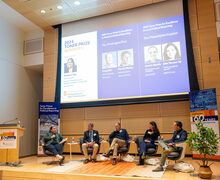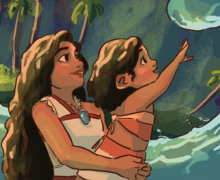Indigenous communities symposium discusses art, resiliency
Maxine Brackbill | Photo Editor
The symposium included several lectures and a panel, as well as an art exhibition at the Syracuse University Art Museum.
Get the latest Syracuse news delivered right to your inbox.
Subscribe to our newsletter here.
Members of the Onondaga Nation and other Indigenous communities from across the country gathered at Syracuse University’s Maxwell School of Citizenship and Public Affairs for a symposium on conservation, climate change and biodiversity on Sunday and Monday.
Speakers at the symposium discussed how Indigenous communities prioritize environmental preservation through art and ancestral practices. The event — titled “Indigenous Resilience, Climate Change, and the Environmental Humanities” — was held in Eggers Hall and hosted by groups including the Native Student Program and the Center for Global Indigenous Culture and Environmental Justice at SU’s College of Arts and Sciences.
The symposium included several lectures and a panel, as well as an art exhibition at the Syracuse University Art Museum.
Linda Infante Lyons, an Alutiiq — or a Southern Alaskan Indigenous person — called on symposium attendees to be hopeful rather than fearful about the implications of climate change in her remarks Sunday.
“If we can learn to love the land, we will take care of it, and artwork is my way of showing that I love the land and I want you to love it as well,” Lyons said.
Lyons said she disagreed with the methods of “end-stage” capitalism, specifically how it focuses too much on maximizing profit and capitalizing on resources. She said she wants the world to move toward a more sustainable way of life similar to how Indigenous people have lived for generations while incorporating modern science and anthropology.
“I’m afraid that we will sort of follow this Western European trajectory, which is very linear… it’s not sustainable,” Lyons said. “It really does sort of predict an end and almost embrace an apocalyptic end.”
Lyons also called for greater representation of Indigenous peoples in international communities.
Brandon Lazore, an Onondaga snipe clan artist, was hired by SU to produce a variety of art about Haudenosaunee culture on campus — including a mural at the newly reopened Native Student Program building located at 113 Euclid Ave. Lazore spoke about the importance of education in Indigenous communities and the optimistic view of the world he hopes to reflect in his artwork.
“My healing is me being able to educate through my art,” Lazore said. “We talked a little bit about our past histories and I chose not to paint about our traumas. I want to talk about things that would lift us up, put us in a good spirit and give us something to be proud about.”
Ali Meders-Knight, a member of the Mechoopda Indian Tribe of Chico in Rancheria, California, described the “post-apocalyptic world” Indigenous people live in where they have lost their ancestral lands, languages and resources.
Meders-Knight also addressed the rate of suicide in the Indigenous community. Non-Hispanic American Indian and Alaska Native people have the highest rate of suicide among racial and ethnic groups in the U.S., according to 2021 data from the Centers for Disease Control and Prevention.
Meders-Knight said that when she had her own struggle with suicidal thoughts, basket weaving and art “saved” her.
“Suicide’s really hard in our community, and it’s not spoken enough about,” Meders-Knight said. “I know youths that have killed themselves, I know adults that have killed themselves.”
Meders-Knight said she believes the best way forward is to have people work on land together and promote self-healing by connecting with ancestors through ancestral traditions.
Looking to the future, Lazore said he wants to leave a lasting impact through art that will inspire many generations of Indigenous people.
“I want our people to be proud of themselves and proud when they see these installations and proud when they see these paintings in museums, or wherever they might land or wherever they might be,” Lazore said. “I know that what I’m doing is gonna last a lot longer than I will.”
Published on November 13, 2023 at 10:47 pm






